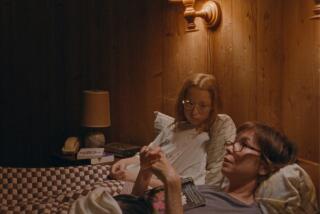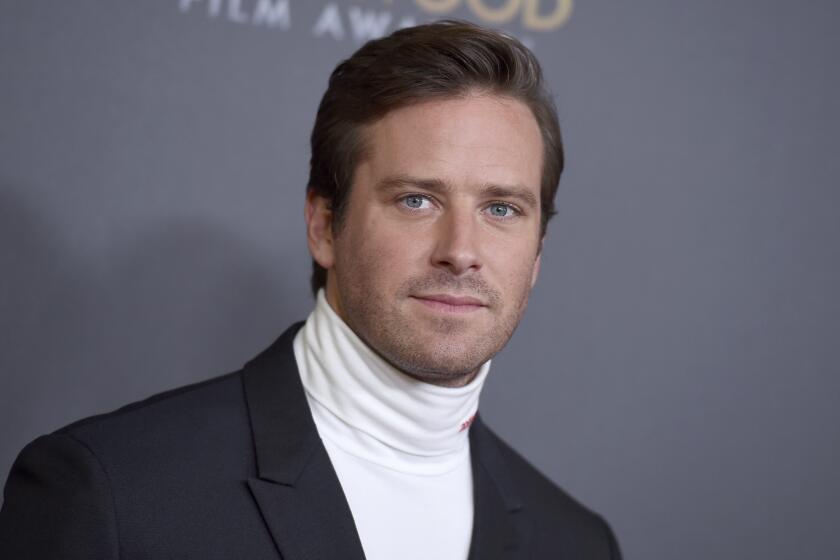Review: ‘Ten Thousand Saints’ lacks a center as it recalls ‘80s
“Ten Thousand Saints” pulsates with full-blooded supporting characters who create a tragic-absurd tapestry of decay and rebellion in the Ronald Reagan years, from depressed New England to volatile New York. It’s too bad the center cannot hold.
The talented writing-directing team of Shari Springer Berman and Robert Pulcini intelligently compress Eleanor Henderson’s 400-page coming-of-age novel. But in the process, their drug-abusing antihero, Jude Keffy-Horn (Asa Butterfield), becomes a pallid stand-in for all children raised without conventional boundaries by post-hippie parents like Harriet (Julianne Nicholson), a glass-blower in Lintonburg, Vt. (a fictionalized version of Burlington), and Les (Ethan Hawke), an artisanal marijuana dealer who left Harriet and his kids and moved his underground business to St. Mark’s Place in the East Village.
SIGN UP for the free Indie Focus movies newsletter >>
Despite Butterfield’s likable efforts, the most memorable thing about Jude is his annoying hairstyle. He sports a horror-punk “devil lock” — hair that drops down the middle of his face, at times obscuring both eyes, at other times drifting sideways for modified Veronica Lake effects. When Jude slices it off, he seems even more diffident. He starts the movie with ersatz poetic narration: “I’ve heard people say that life is like a river, and we’re all just tiny minnows, struggling through the freeze, the thaw and the flow.” You can forgive that speech (original to the film), but you can’t ignore the dramatic problem that Jude does come off as a little fish buffeted by life.
When he’s still a tyke, Les genially informs him that the family is splitting up and he’s adopted. When he’s a teenager, his best friend and fellow stoner Teddy (Avan Jogia) has secret sex with Eliza (Hailee Steinfeld), the precocious daughter of Les’ well-off, longtime lover, Di (Emily Mortimer).
Jogia is superb as Teddy: scruffy, sweet, avid for experience, loyal to a fault. But calamity takes him out of the picture — we keenly feel his loss — and sends Jude reeling to New York. Eventually he and Eliza form an alternative family with Teddy’s half brother, Johnny (Emile Hirsch), a tattoo artist and squatter. Johnny makes hard-core music with a punk band devoted to “straight edge” — rock ‘n’ roll without sex and drugs.
The film’s ruling irony is juicy: While roaming the grungy, dangerous Gotham of the Ed Koch era, Jude learns discipline and responsibility, partly from running with Johnny’s crowd and partly from his devotion to Eliza.
The audience loves Eliza, too. Steinfeld creates a child-woman shocked into adulthood. It’s a three-dimensional performance forged in all four chambers of the heart.
Hawke is almost as moving. One of our freest, most imaginative actors, he portrays Les’ unstated morality — if it feels good, it is good — as a grubby kind of comic wisdom. You believe in his power to captivate Nicholson’s wary, down-to-earth Harriet as well as Mortimer’s upscale, tightly wound Di. Nicholson and Mortimer are funny and touching as matched opposites. In one ultra-natural scene, the two transcend their differences to hash out what’s best for their kids.
The filmmakers know that the art-house audience will compare bygone New York nightmares with the gentrified stability of today. Their coda depicts families frolicking where police and homeless rioted in 1988 in Tompkins Square Park. The effect should be electric, but it’s softened by excessive wistfulness.
As always, Berman and Pulcini suffuse their movie with a let’s-try-anything spirit — and liberate most of their actors. What keeps “Ten Thousand Saints” from being another “American Splendor” (2003) or “Cinema Verite” (2011) is that this time, their tapestry has a hole in the center, where their pale antihero cannot pull the colorful threads together.
------------
‘Ten Thousand Saints’
MPAA rating: R for drug use including teens, language including sexual references
Running time: 1 hour, 53 minutes
Playing: Laemmle’s Royal, West L.A.
More to Read
Only good movies
Get the Indie Focus newsletter, Mark Olsen's weekly guide to the world of cinema.
You may occasionally receive promotional content from the Los Angeles Times.










